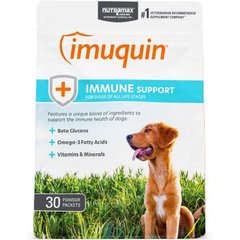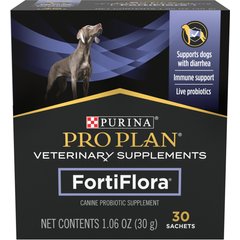How to Get Rid of Worms in Dogs
Why do veterinarians always want a stool sample at annual visits? Well, the stool sample is used to screen your dog for intestinal parasites—or worms—in their poop.
Many pet parents that come into the office think that their dog couldn’t possibly get worms for one reason or another. But every dog is at risk for worms, no matter where they live or how much time they spend outside.
You might also think that your dog doesn’t have worms because you haven’t seen any.
A fecal exam is needed because the majority of worms will not be visible to the human eye—except for tapeworms, in some instances. The vet will perform a special test or examine the sample under a microscope to check for worms.
This article will tell you everything you need to know about the most common parasitic worms in dogs, and how to treat and prevent them.
Jump to a section:
How Do Dogs Get Worms?
These are a few different ways a dog can get worms. These will be explained further within the sections for each type of worm.
Eating Infected Stool
Worms are usually transmitted through a fecal-oral route. That means that your pet comes into contact with microscopic parasitic eggs that are present in fecal material (poop) and accidentally ingests the eggs.
Passed to Puppies From the Mother Dog
Puppies can get worms from their mother. This can happen a few different ways:
-
Through the placenta before puppies are born
-
Through a mother’s milk when puppies are nursing
Eating Raw Meat or Prey Animals
Some tapeworms and flukes can be transmitted when a dog eats raw meat.
These types of worms form cysts in the muscle tissue of animals. When they are consumed, they become active and multiply.
Eating External Parasites
Some worms are transmitted through another host.
For example, tapeworms are transmitted via fleas. The parasite lives inside the flea, so when a dog accidently eats fleas, they become infected with the parasite.
Through Skin Contact
Dogs can get hookworms by coming into contact with stool that has the larvae in it. The hookworms can burrow through the skin and infect the dog.
Vet Recommended Health Support
- Nutramax Imuquin Immune Support Powder Immune Supplement for Dogs, 30 count$24.99Chewy Price
- Purina Pro Plan Veterinary Diets FortiFlora Powder Probiotic Digestive Supplement for Dogs, 30 count$30.99Chewy Price
- Purina Pro Plan Adult Sensitive Skin & Stomach Salmon & Rice Formula Dry Dog Food, 16-lb bag$54.48Chewy Price
- Virbac Epi-Otic Advanced Ear Cleaner for Dogs & Cats, 4-fl oz bottle$12.34Chewy Price
4 Types of Worms in Dogs
The most common types of parasitic worms in dogs include hookworms, roundworms, whipworms, and tapeworms.
Below are pictures of these worms in dog poop. This is what worms/parasite eggs look like underneath a microscope.
 | 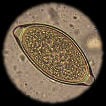 |  |  |
| Roundworm Egg | Whipworm Egg | Hookworm Eggs | Tapeworm Egg Packet |
Hookworms
Hookworms are more common in dogs than in cats. They fasten to the wall of the small intestine and suck blood, and they are a serious threat to dogs.
These parasitic worms can be deadly for puppies if they lose too much blood.
What Do Hookworms Look Like?
Hookworms are very small, thin worms with hook-like mouthparts that they use to attach to the intestinal wall. They shed eggs that are then passed through the feces, but these eggs are so tiny that you can’t see them in your dog’s poop.
How Do Dogs Get Hookworms?
Adult dogs get hookworms from contact with the larvae in stool-contaminated soil (the larvae can burrow through the skin) or from ingesting larvae from the environment or in a prey animal’s tissues.
Nursing puppies can also get hookworms. The larvae in their mother’s body can migrate to the mammary glands and be passed on through the milk.
Are Hookworms Dangerous to Dogs?
A severe hookworm infestation can kill puppies, often due to severe anemia from the loss of blood caused by the hookworms' feeding. When they move to a new feeding site, they leave behind small, bleeding ulcers.
What Are the Signs of Hookworms in Dogs?
While many adult dogs won’t have any clinical signs, they still are responsible for spreading eggs in the environment.
If symptoms do develop, they may include:
-
Poor stamina
-
Dark and tarry stools
-
Bloody diarrhea
-
Weight loss
-
Anemia
-
Progressive weakness
How to Get Rid of Hookworms
Diagnosis of hookworms is made by examining the feces under a microscope. Once diagnosed, your veterinarian will provide a dewormer to kill the hookworms.
Roundworms
A large percentage of puppies are born with microscopically small roundworm, or ascarid, larvae in their tissues. Adult dogs can also get roundworms, although you typically won’t see any signs.
What Do Roundworms Look Like?
Roundworms may be seen in vomit or stool, particularly after worming. They are light in color and look like spaghetti. Roundworms can be up to several inches long.
How Do Dogs Get Roundworms?
There are a few different ways a dog or puppy can get roundworms.
From Their Mother
The larvae are introduced to the developing puppy right in the mother's uterus—via migration through the placenta.
Less commonly, roundworm larvae can be transferred to the nursing puppy from the mother's milk.
When the puppies who were infected in utero are born, the larvae make their way to the intestinal tract, where they grow into adults that are around 5 inches in length.
From Their Environment
Female roundworms can produce up to 85,000 eggs in just one day. These eggs are protected by a hard shell, which enables them to exist in soil for years. The eggs that adult roundworms pass in the stool can reinfest the animal or other dogs when eaten.
After ingestion, the microscopic larvae come out of the eggs and migrate to the animal's lungs, where they are coughed up, swallowed, and grow up to be adults in the small intestine.
From Wild Animals
Dogs can also contract roundworms by eating prey animals that have larvae in their tissues.
Are Roundworms Dangerous to Dogs?
If not treated in time, a severe infestation can cause death by intestinal blockage or other means.
What Are the Signs of Roundworms in Dogs?
Clinical signs of roundworms aren’t usually seen in adult dogs. Puppies with roundworms often have a pot-bellied appearance and poor growth. You may also see diarrhea or roundworms in a dog’s poop or vomit, especially after deworming.
How to Get Rid of Roundworms
Monthly dewormers are used to kill roundworms in dogs.
Worming dogs while they are pregnant and nursing can help reduce the numbers of roundworms in their offspring, but since almost all wormers work only on the adult parasites in the intestinal tract and not on dormant larvae in tissues, some transmission is still likely to occur to the puppies.
Giving a monthly dewormer to the puppies after they finish weaning at 6-8 weeks of age will prevent them from getting parasites for the rest of their lives.
Whipworms
This parasite is more often seen in dogs than cats. They live in the cecum, which is attached to the first section of the dog's large intestine.
What Do Whipworms Look Like?
Adult whipworms, although seldom seen in the stool, look like tiny pieces of thread, with one end enlarged.
How Do Dogs Get Whipworms?
Dogs with whipworms shed eggs in their stool. These eggs are incredibly hardy and can survive for years, still capable of infecting dogs when they are eaten.
What Are the Signs of Whipworms in Dogs?
Many dogs with whipworms develop few symptoms, but they could include weight loss, dehydration, anemia, a pot-bellied appearance, and diarrhea that may contain blood or mucus.
Infestations can be difficult to identify, since whipworms shed eggs intermittently. An examination of even several stool samples may not reveal the presence of whipworms.
How To Treat Whipworms
Because whipworm infestations can be hard to diagnose, veterinarians may prescribe a whipworm medication based upon clinical signs only.
Tapeworms
Tapeworms are flat, segmented worms that can live in a dog’s intestines. They need a flea to carry them in order to infect a dog (when a dog ingests the flea).
Tapeworms tend to cause very mild disease in dogs, but in severe infections cause malabsorption of nutrients and diarrhea similar to that of a roundworm infection.
What Do Tapeworms Look Like? 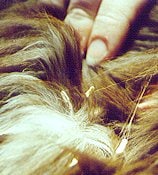
Tapeworms can reach up to two feet in length within the intestines.
Each tapeworm consists of many segments, though they only release the last ones in the chain as they are passed out of the dog’s body. These segments, or proglottids, can be seen in a dog’s stool or stuck in a pet’s fur.
If you were to see an entire tapeworm, you would notice that they have a small head at one end with many tiny brick-like, repeating segments.
Many tapeworm cases are diagnosed simply by seeing these tiny segments attached to the pet’s fur around the anus or under the tail. They even move around a bit shortly after they are passed and before they dry up, and they look like little grains of rice or confetti. It is also these segments of the tapeworm that contain the eggs.
How Do Dogs Get Tapeworms?
Once dogs shed tapeworm eggs, flea larvae eat them. Dogs get tapeworms by eating infected fleas and by eating wildlife or rodents that are infested with tapeworms or fleas.
Are Tapeworms Dangerous to Dogs?
Most pets do not become sick as a result of a tapeworm infestation, but they can develop irritation around the anus.
What Are the Signs of Tapeworms in Dogs?
There aren’t many noticeable signs of tapeworms in dogs.
You may notice your dog scooting or licking or biting their tail area. Check under the tail to see if you can see the rice-like tapeworm segments stuck in the fur or near the anus.
How to Get Rid of Tapeworms
Tapeworms cannot be killed by many common over-the-counter wormers. It is essential to use one that is labeled specifically for tapeworms.
How to Tell If Your Dog Has Worms
The best way to find out if your dog has worms is to have your vet perform a fecal exam.
Here are some tips for how you can to tell if your dog has worms.
Signs of Worms in Dogs
Pets often don’t have any symptoms with mild or new worm infestations, but as things get worse, worms may cause:
-
Diarrhea, perhaps with blood
-
Worm or worm segments visible in the stool or on the dog’s hind end
-
Weight loss
-
Dry hair
-
General poor appearance
-
A bloated belly
-
Vomiting, perhaps with worms in the vomit
Some worms can remain dormant in the pet's body and become problematic at a later time. For example, dormant hookworms can reinfest a dog’s intestinal tract after worming or become active in the later stages of pregnancy and infect soon-to-be-born puppies and kittens.
Can You See Worms? What Do Worms Look Like? 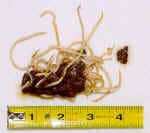
Look at the photo on the right. You may find roundworms in a dog’s stool or vomit, particularly after worming.
It’s rare to see entire tapeworms, but they shed body segments that contain their eggs. Segments of tapeworms will look like a piece of rice in your dog’s poop or around the anus.
Hookworms and whipworms are seldom seen in a dog’s stool, which is precisely why a stool sample is required.
To reveal the presence of roundworms, hookworms, and whipworms, a veterinarian needs to use a microscope to look for their tiny eggs in a specially prepared sample of feces.
Fecal Exam From Veterinarian
Early diagnosis for the presence and type of intestinal parasite is vital for your pet’s health and to prevent environmental contamination.
To do this, your veterinarian will usually mix a stool sample (only about a teaspoonful is needed) with a special solution and then use centrifuge to bring the eggs to the top of the liquid.
This top layer is then transferred to a glass slide and examined under the microscope.
Many veterinarians include the stool check as part of routine health examinations.
(Note: Tapeworm eggs do NOT generally show up in stool samples. Tell your veterinarian if you spot these rice-like segments in the stool or caught in the fur under the tail.)
Can Humans Get Worms From Dogs?
Yes, some worms found in dogs are potential health hazards for humans.
You can get hookworms if you come into contact with infected soil, such as walking with bare feet. If hookworm larvae penetrate the skin, they can cause "cutaneous larval migrans," an itchy skin disease. Occasionally, hookworm larvae can migrate into deeper tissues and cause more serious health problems.
You can get roundworms from your dog if you accidently touch fecal material from your dog and then your mouth. Children are at most serious risk, especially if they play in an environment where dog or cat feces may be present, such as in a sandbox.
Roundworm eggs, if ingested, are even more dangerous than hookworms. Once in the body, the larvae can migrate almost anywhere, including the liver, lungs, eyes, and brain.
In order to get tapeworms, you would need to ingest an infected flea, which is not likely.
Humans cannot be infected by the same whipworm species that infects dogs, but there is another type of whipworm that can infect humans.
Please take the worming advice of your veterinarian seriously and adhere to strict sanitation principles whenever pets and children are in close contact.
To learn more about how pet parasites can affect people, look at the Centers for Disease Control website at www.cdc.gov.
How to Get Rid of Worms in Dogs
There is one tried-and-true way to get rid of worms in dogs: dewormer medication.
The type of dewormer will depend on the type of worm present. Not all worms respond to the same treatment, and no single wormer works against all kinds of parasites.
Some nonprescription wormers are quite ineffective at removing worms from the dog or cat. Your veterinarian can recommend the best kinds of wormers available for the particular type of parasite your pet has.
What Are the Side Effects of Deworming?
In my experience, most dogs don’t exhibit any side effects from deworming.
However, if side effects do occur, the most common symptoms include:
-
Lethargy
-
Vomiting
-
Diarrhea
-
Neurologic changes
They tend to be mild and resolve without any veterinary attention.
The only exceptions are dogs that have a multi-drug resistance gene mutation, or MDR1 gene, which can increase the likelihood of adverse reactions and hypersensitivity to deworming medications.
Please consult with your local veterinarian if you want to get your dog tested for this gene mutation.
Are There Home Remedies for Worms in Dogs?
Generally speaking, prescription dewormers will be safer and/or more effective than many over-the-counter worm medications.
There are no home remedies to treat or prevent parasitic worms. Please consult with your local veterinarian for best choice of dewormer based on where you live and your pet’s lifestyle.
How to Prevent a Dog From Getting Worms
Using a monthly, commercially-available dewormer can protect against heartworms and intestinal parasites indefinitely.
Most parasites have a life cycle of three to four weeks, so you can prevent and treat most parasites if you give the medication monthly.
Giving a monthly dewormer to your pregnant dog will prevent transmission to her offspring. Then the puppies can start on a dewormer after they finish weaning.
Here are some other ways you can help your dog avoid contracting worms.
Clean Up After Your Pet
Pets can become reinfested with worms immediately after they are dewormed, so prevention is very important. Remove feces from your yard promptly.
Avoid the Dog Parks
Pets that spend a lot of time where other pets congregate, like the dog park, can be exposed to worm eggs or larvae there.
Use Flea and Tick Prevention
Flea control is important for preventing tapeworms. Some preventive medications for heartworms also help control certain types of intestinal worms.
Don’t Let Your Dog Chase Wildlife
Dogs that hunt rodents and other prey animals are also at high risk for worms.
Get Annual Fecal Exams at Your Vet
Have your dog’s feces checked at least annually (more frequently for puppies).
Depending on your dog’s particular situation, your veterinarian may recommend regular deworming treatments instead of or in addition to fecal examinations.
Featured Image: iStock.com/Lunja

